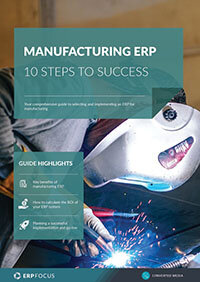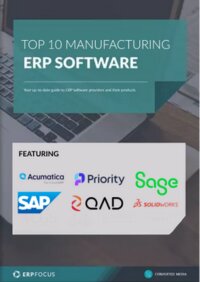Why your ERP should support supplier integration
Are there inefficiencies in your supply chain? SCM (supply chain management) is evolving at an incredible rate. New ways to measure metrics are being developed every day. Everyone from Google to Amazon is analyzing SCM data to find ways of opening up bottlenecks and making their processes leaner. Whether that means automated RFID tags on packages to provide coded instructions to warehouses, or GPS augmented delivery systems that actively update route information to shave minutes off of each delivery. These innovations make competition fierce between manufacturers, retailers, and logistics business as they each rush to gain an advantage.
There are other ways to get ahead, though; a more egalitarian partnership between suppliers, manufacturers, and retailers. Utilizing a comprehensive ERP allows you to tackle inefficiencies in a previously siloed supply chain.
Supporting ERP integration with your supplier saves time and money, boosting your bottom line and enhancing key relationships with your valued partners. Here’s how...
The importance of integration
Good business depends on good communication. Streamlining communications with your suppliers helps cement a mutually beneficial relationship. The leaner your efforts and the stronger your communications, the faster you and your suppliers can make coordinated efforts to adapt to changes in the marketplace.
Any company can have suppliers, but having a secure and mutually beneficial relationship puts you at a unique advantage with distinct benefits you can’t get without the right tools.
Check out our complete step-by-step guide to selecting and implementing manufacturing ERP software
ERP supplier integration is the most effective way to create that relationship. Once that relationship is established, both parties reap the benefits.
The benefits of ERP in supply chain management
ERP supply chain management lowers overhead costs, allowing more income to be counted as profit. It accomplishes this through:
- Creating more auditable and sharable control systems
- Creating active/engaged supplier relationships
- Improving management
- Increased ability for micromanagement of operations
- Improved efficiency / time-saving initiatives
- Improved productivity
Creating more auditable and sharable control systems
ERP systems allow you to create shareable data to improve your supply arrangements. Sending reams of emails and other documents back and forth to keep all parties in your supply chain updated is slow, outdated and prone to human error. With an SCM enabled ERP, a central hub of information can be accessed by anyone with the right permissions, eliminating communication downtime in the supply chain while keeping your data secure and reducing missteps in your processes.
Instead of taking inventory and sending the information when requested, it’s already tracked in your ERP and can instantly be accessed.
Creating active and engaged supplier relationships
Competence and an honest human touch will earn you more loyal business relationships than any of the “next big sales tricks”. The Harvard Business Review has found that when judging whether a future business partner is a safe bet to hedge, customers look at two things:
- How much do they like said individual or group (warmth and trustworthiness)?
- Does said individual or group have the competence to deliver?
Having more accurate, transparent communications improves perceptions all round. Integrating your supplier into your ERP system provides the highest level of quality and accuracy in your communications. When everything is tracked and documented automatically, and that information is universally accessible, miscommunications don’t have the opportunity to rear their ugly heads in the first place.
Not only does ERP integration minimize miscommunications, but it fosters more intuitive communications. Sharing ERP system access means you can offer earlier warnings for quantity adjustments, better lead times and more reliable predictive modeling.
Not only do these factors improve resource planning, but position you in a more respectable light.
Improving management
You can use ERP software to manage the sales and purchasing processes from beginning to end. Improving your management processes adds value to your supplier relationships. This is accomplished through universally trackable payment terms, lead times, and streamlined communications via easy viewing of products and prices.
Increased ability for micromanagement of operations
Maintaining good supplier relationships demands transparency. Integrated systems don’t just help establish a more robust supply chain, but contribute to a lean and agile business. Maintaining this standard requires you to make quick changes to your inventory in response to demand. These changes affect your supplier who also wants to create a lean and agile business model.
The balance between inventory, sales demand, supplier needs, and the market environment can only be struck through the implementation of integrated ERP software. It creates more transparent dealings while highlighting the needs of one another’s businesses, allowing you both to thrive as you proactively address situations before they constrict either business.
Improved efficiency / time-saving initiatives
When you save time, you save money.
Integrated ERPs allow greater process automation, increasing your productivity. The immediate benefit is obvious; you’re more efficient, so you can get more done. Beyond that, though, you can improve business relationships.
The best thing you can do to avoid human error is to remove the chance for it to occur. Management automation can keep stock at the right levels. When stocks reach a certain point they can be ordered automatically, keeping a steady inventory. This cuts down on time spent ordering as well as eliminating lost time due to human error made during the ordering process.
Greater efficiency on either side of the supply chain translates into greater competence. When you know what you’re doing and you’re good at it there’s more reason to trust you in future business plans.
Improved productivity
All of these benefits contribute to greater productivity.
That means improved utilization of resources, creating cost-savings that allow you to reinvest to further grow your business. Growth in your business leads to stock purchases from your supply chain.
Everything feeds back into itself creating a profitable wave that everyone on your supply chain, from beginning to end, will profit from.
Requirements for supplier integration
You want those benefits. You want to grow, and you need to establish the groundwork for adapting an ERP. Before you dive headlong into new tech, you must qualify your business needs.
Those needs will hinge upon vendor performance, available training, and scalability.
First, establish your goals. What do you want to see accomplished through ERP integration? This could be:
- Automation of tasks
- Improved cash flow
- Improved transparency and accuracy
- Automated reporting for quicker turnaround times.
Soft skill requirements
When considering different vendors you need to be conscious of your goals. Ask vendors how they can help provide these to you. The responsiveness, customer service, and training available from the vendor will dictate if you want to do business with them. Vet your provider just as strictly as you would a new hire or business partner.
We’ll call these the soft skill requirements.
Technical requirements
Your IT infrastructure will dictate what you can use and what is needed. If your office runs on PC, a Mac-specific ERP is useless. Similarly, you don’t need E-commerce integration if you don’t have E-commerce operations.
This is not an exhaustive list, but consider these examples of controlling variables to help narrow down what will dictate your needs:
- Operation system
- Integration to MS Office
- Client computer requirements
- Mobility options
- Updates and upgrade process frequency
- Bandwidth requirements
- Client access points (web client vs remote desktop)
- Cloud vs on-premise
Financial requirements
Straightforward; what is your budget? Don’t buy beyond your means. Beyond this, however, your financial modules need to focus on ATO compliance, management reporting, efficient information processing, and financial reporting. Consider if you need:
- A fixed assets module
- Cash management functionality
- Financial reporting
- Cash flow analysis
- Any other functions offered by your prospective vendor
Distribution requirements
The side that directly affects your supply chain, consider if you need:
- Bin location functionality
- Warehouse management options
- Purchase planning and forecasting
- Paperless warehouse options
- Serial number tracking
- Stock take
- Goods receipting
- EDI requirements
- Freight management integration
- Price lists
- Stock expiry dates
Manufacturing requirements
- Resource planning
- WIP tracking
- Work orders
- Scheduling
- Material Requirements Planning
Customer relationship management requirements
- CRM automation
- Marketing automation
- Newsletter emailing
- Reporting
- Pipeline management
- Marketing campaign management
- Service management
- Service scheduling
- Service contracts
- Timesheets
Reporting requirements
- Real-time analytics
- Key performance indicators
- Pre-built reports
ERP integration will improve your business model
Wherever your demands lead you, integrating the right ERP alongside your supplier will plant the seeds to an improved and more profitable business relationship. This counts for both the hard numbers and the trust built around more reliable communications.
Free white paper

Manufacturing ERP: 10 steps to success
Complete step-by-step guide to manufacturing ERP software

Featured white papers
Related articles
-

4 training tips for manufacturing ERP success
These four training tips will help your employees get the most out of your new manufacturing ERP ...
-

Secret KPI: Why Your ERP Implementation Team Matters More Than Software
Learn how Godlan ensures successful ERP implementation for manufacturers with proven strategies &...
-

Nine signs you need an eCommerce ERP integration
A guest blog from Brightpearl discussing eCommerce ERP and integration



